Digital Fine Contrast is a contrast-enhancing display technology introduced in 2006 by LG Display. It is used in the company's "Flatron" line of TFT monitors and implements a 'smart function' whereby it dynamically detects the characteristics of each frame to be displayed and automatically adjusts its contrast to obtain a sharper and more vivid image. The system comprises three units: ACR (Auto Contents Recognition), DCE (Digital Contrast Enhancer) and DCM (Digital Contrast Mapper). [1]
The initial announcement [2] claimed monitors with DFC could achieve a contrast ratio of 1600:1, while later products have been presented as capable of ratios even as high as 2,000,000:1, and there are SAMSUNG LCD TV sets that claim 500,000:1 with LCD monitors claiming 5,000,000:1.

A computer monitor is an output device that displays information in pictorial or textual form. A discrete monitor comprises a visual display, support electronics, power supply, housing, electrical connectors, and external user controls.

A liquid-crystal display (LCD) is a flat-panel display or other electronically modulated optical device that uses the light-modulating properties of liquid crystals combined with polarizers. Liquid crystals do not emit light directly but instead use a backlight or reflector to produce images in color or monochrome. LCDs are available to display arbitrary images or fixed images with low information content, which can be displayed or hidden: preset words, digits, and seven-segment displays are all examples of devices with these displays. They use the same basic technology, except that arbitrary images are made from a matrix of small pixels, while other displays have larger elements. LCDs can either be normally on (positive) or off (negative), depending on the polarizer arrangement. For example, a character positive LCD with a backlight will have black lettering on a background that is the color of the backlight, and a character negative LCD will have a black background with the letters being of the same color as the backlight. Optical filters are added to white on blue LCDs to give them their characteristic appearance.
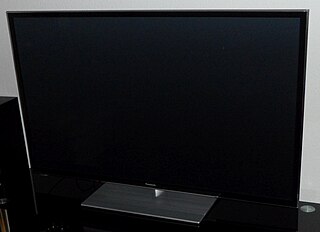
A plasma display panel (PDP) is a type of flat panel display that uses small cells containing plasma; ionized gas that responds to electric fields. Plasma televisions were the first large flat panel displays to be released to the public.
Apple Inc. sold a variety of LCD and CRT computer displays in the past. Apple paused production of their own standalone displays in 2016 and partnered with LG to design displays for Macs. In June 2019, the Pro Display XDR was introduced, however it was expensive and targeted for professionals. Nearly three years later, in March 2022, the Studio Display was launched as a consumer-targeted counterpart to the professional monitor. These two are currently the only Apple-branded displays available.

An LCD projector is a type of video projector for displaying video, images or computer data on a screen or other flat surface. It is a modern equivalent of the slide projector or overhead projector. To display images, LCD projectors typically send light from a metal-halide lamp through a prism or series of dichroic filters that separates light to three polysilicon panels – one each for the red, green and blue components of the video signal. As polarized light passes through the panels, individual pixels can be opened to allow light to pass or closed to block the light. The combination of open and closed pixels can produce a wide range of colors and shades in the projected image.
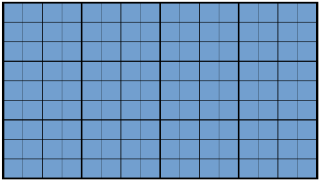
16:9 (1.78:1) is a widescreen aspect ratio with a width of 16 units and height of 9 units.

The display resolution or display modes of a digital television, computer monitor or display device is the number of distinct pixels in each dimension that can be displayed. It can be an ambiguous term especially as the displayed resolution is controlled by different factors in cathode ray tube (CRT) displays, flat-panel displays and projection displays using fixed picture-element (pixel) arrays.
The contrast ratio (CR) is a property of a display system, defined as the ratio of the luminance of the brightest shade (white) to that of the darkest shade (black) that the system is capable of producing. A high contrast ratio is a desired aspect of any display. It has similarities with dynamic range.
A thin-film-transistor liquid-crystal display is a variant of a liquid-crystal display that uses thin-film-transistor technology to improve image qualities such as addressability and contrast. A TFT LCD is an active matrix LCD, in contrast to passive matrix LCDs or simple, direct-driven LCDs with a few segments.

A super-twisted nematic (STN) display is a type of monochrome passive-matrix liquid crystal display (LCD).
LG Display is one of the world's largest manufacturers and supplier of thin-film transistor liquid crystal display (TFT-LCD) panels, OLEDs and flexible displays. LG Display is headquartered in Seoul, South Korea, and currently operates nine fabrication facilities and seven back-end assembly facilities in Korea, China, Poland and Mexico.
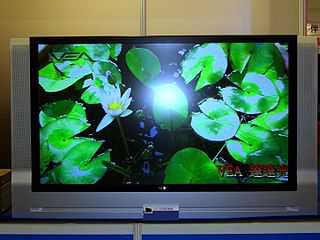
Large-screen television technology developed rapidly in the late 1990s and 2000s. Prior to the development of thin-screen technologies, rear-projection television was standard for larger displays, and jumbotron, a non-projection video display technology, was used at stadiums and concerts. Various thin-screen technologies are being developed, but only liquid crystal display (LCD), plasma display (PDP) and Digital Light Processing (DLP) have been publicly released. Recent technologies like organic light-emitting diode (OLED) as well as not-yet-released technologies like surface-conduction electron-emitter display (SED) or field emission display (FED) are in development to replace earlier flat-screen technologies in picture quality.
Developed by Mitsubitshi Electric Research Laboratories, a privacy-enhanced computer display allows information that must remain private to be viewed on computer displays located in public areas by employing the use of both ferroelectric shutter glasses and a unique device driver.
"21:9" is a consumer electronics (CE) marketing term to describe the ultrawide aspect ratio of 64:27, designed to show films recorded in CinemaScope and equivalent modern anamorphic formats. The main benefit of this screen aspect ratio is a constant display height when displaying other content with a lesser aspect ratio.

4K resolution refers to a horizontal display resolution of approximately 4,000 pixels. Digital television and digital cinematography commonly use several different 4K resolutions. In television and consumer media, 3840 × 2160 is the dominant 4K standard, whereas the movie projection industry uses 4096 × 2160.
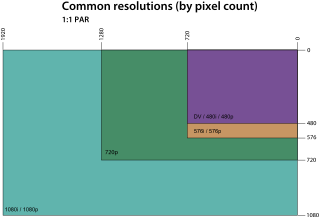
The graphics display resolution is the width and height dimension of an electronic visual display device, measured in pixels. This information is used for electronic devices such as a computer monitor. Certain combinations of width and height are standardized and typically given a name and an initialism which is descriptive of its dimensions. A graphics display resolution can be used in tandem with the size of the graphics display to calculate pixel density. An increase in the pixel density often correlates with a decrease in the size of individual pixels on a display.
IPS is a screen technology for liquid-crystal displays (LCDs). In IPS, a layer of liquid crystals is sandwiched between two glass surfaces. The liquid crystal molecules are aligned parallel to those surfaces in predetermined directions (in-plane). The molecules are reoriented by an applied electric field, whilst remaining essentially parallel to the surfaces to produce an image. It was designed to solve the strong viewing angle dependence and low-quality color reproduction of the twisted nematic field effect (TN) matrix LCDs prevalent in the late 1980s.
A curved screen is an electronic display device that, contrasting with the flat-panel display, features a concave viewing surface. Curved screen TVs were introduced to the consumer market in 2013, primarily due to the efforts of Korean companies Samsung and LG, while curved screen projection displays, such as the Cinerama, have existed since the 1950s.
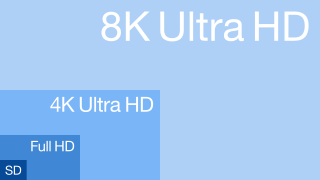
5K resolution refers to display formats with a horizontal resolution of around 5,000 pixels. The most common 5K resolution is 5120 × 2880, which has an aspect ratio of 16∶9 with around 14.7 million pixels, with exactly twice the linear resolution of 1440p and four times that of 720p. This resolution is typically used in computer monitors to achieve a higher pixel density, and is not a standard format in digital television and digital cinematography, which feature 4K resolutions and 8K resolutions.